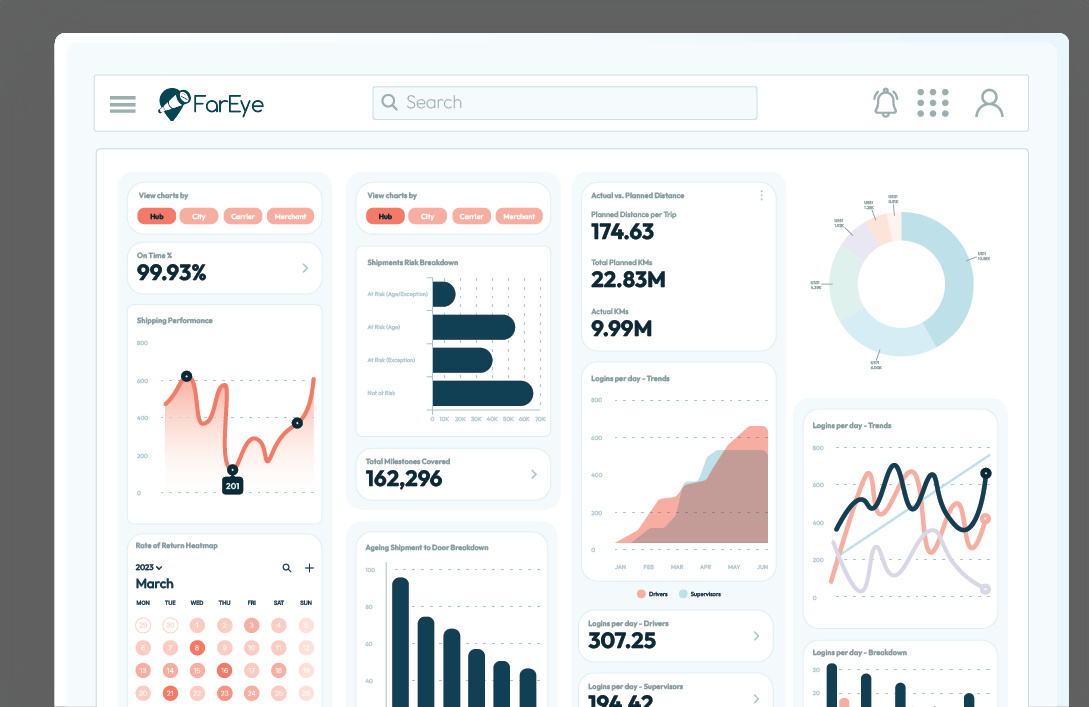- Last-Mile
Revolutionizing Delivery: The Power of Last Mile Analytics
What is last mile analytics?
Last mile analytics is the process of collecting, analyzing, and interpreting data related to the last leg of a product or service delivery. It involves gathering data on the delivery process from the distribution center to the end user, analyzing that data to identify trends and areas for improvement, and using those insights to optimize delivery processes and enhance the customer experience.
Last mile analytics is used across industries such as e-commerce, logistics and transportation, healthcare, and retail to increase efficiency, reduce costs, and improve customer satisfaction.



Last-mile delivery challenges deal with information and delay on the one hand and huge data loss on the other.
To have a deeper understanding of the operations and the analytical needs of service organizations, it is important to understand and address your needs on a day-to-day basis, as well as on a long-term strategic level. The key to success for organizations seeking to take advantage of this opportunity is:
- Leverage all your current data and enrich it with new data sources
- Enforce data quality policies and leverage today’s best technology and people to support the policies
- Relentlessly seek opportunities to empower your enterprise with fact-based decision-making
- Embed your analytic insights throughout your organization
With the humongous amount of data generated, it is important to understand what to do with it. Because the analytics are contextual, enterprises can build confidence in the analytics and trust will result in using analytic insights to trigger business events. By automatically triggering events, business friction will be greatly reduced. Algorithmic trading and supply chain optimization are just two typical examples where predictive analytics to proliferate in every facet of the business.


Breakup of Last-mile delivery analytics
Analytics that can be done in the last mile is divided into four areas: dashboard analytics, Heat maps, predictive analytics, and reporting. These analytics provide an in-depth understanding of the operations on a day-to-day level.
Dashboard analytics
Dashboard delivers strategic value to service organizations by giving key performance metrics at a go. It helps to view real-time and historic data in the same dashboard to identify trends and areas of opportunity. Also, it helps in gaining a 360-degree view of what is going on the field.
Predictive analytics
We believe that predictive analytics gives a deeper understanding of the future outcomes with some degree of likelihood. Predictive analytics is an area that deals with extracting information from data and using it to predict trends and behavior patterns. With predictive analytics, businesses can drastically improve last-mile visibility. Logistics companies will be able to understand:
- Where to open new hubs?
- Where are customer requests spread?
- New orders likely to come in?
Heat maps
Heat maps helps you in generating descriptive and predictive analytics that helps in understanding what happened, and what is likely to happen and helps you in analyzing and planning it on the field. With heat maps, you will have a clear view on:
- Where to recruit more workforce
- Where new hubs are to be created
- Number of delivery requests
Digitalized reporting
Digitalized reports help in reducing the time taken in generating the run sheets and manual reports at the end of the day. It also helps in securing storage of data, easy retrieval and eliminates the time taken in handling admin work. Digitalized reports enhance the ability to provide accurate, timely and transparent responses.
- Reduces admin work
- Increases employee satisfaction
- Auto-generated reports
These analytics helps logistics companies to analyze their operations and strengthen their last mile by measuring Key Performance Indicators (KPI), generating meaningful insights that help in making smart decisions.
Use Cases for Last Mile Analytics
Last mile analytics is a valuable tool that can be applied to various industries to optimize delivery processes and enhance the customer experience. Here are some common use cases for last mile analytics:
- E-commerce: In the e-commerce industry, last mile analytics is used to track the delivery of goods from the warehouse to the customer's doorstep. By analyzing data on delivery times, routes, and customer feedback, companies can identify bottlenecks in the delivery process and improve the overall customer experience.
- Logistics and transportation: Last mile analytics is also used in the logistics and transportation industry to optimize the delivery of goods and services. By collecting data on traffic patterns, weather conditions, and other variables that can affect delivery times, companies can adjust their delivery routes and schedules to ensure timely and efficient delivery.
- Healthcare: In the healthcare industry, last mile analytics is used to track the delivery of medical supplies and equipment to hospitals and clinics. By analyzing data on delivery times and equipment usage, healthcare providers can optimize their supply chain and ensure that critical equipment is available when and where it is needed.
- Retail: Last mile analytics is also used in the retail industry to track the delivery of products to stores and customers. By analyzing data on delivery times, routes, and customer feedback, retailers can optimize their delivery processes and improve the overall customer experience.
In all these industries, last mile analytics helps companies to improve their delivery processes, reduce last mile delivery costs, and enhance the customer experience. By identifying areas for improvement and making data-driven decisions, companies can optimize their operations and gain a competitive advantage in the marketplace.



Komal Puri is a seasoned professional in the logistics and supply chain industry. As the AVP of Marketing and a subject matter expert at FarEye, she has been instrumental in shaping the industry narrative for the past decade. Her expertise and insights have earned her numerous awards and recognition. Komal’s writings reflect her deep understanding of the industry, offering valuable insights and thought leadership.
Let's Talk to Our Experts and Optimize Your Deliveries Today!
An expert from our team will reach out within 24 hours



